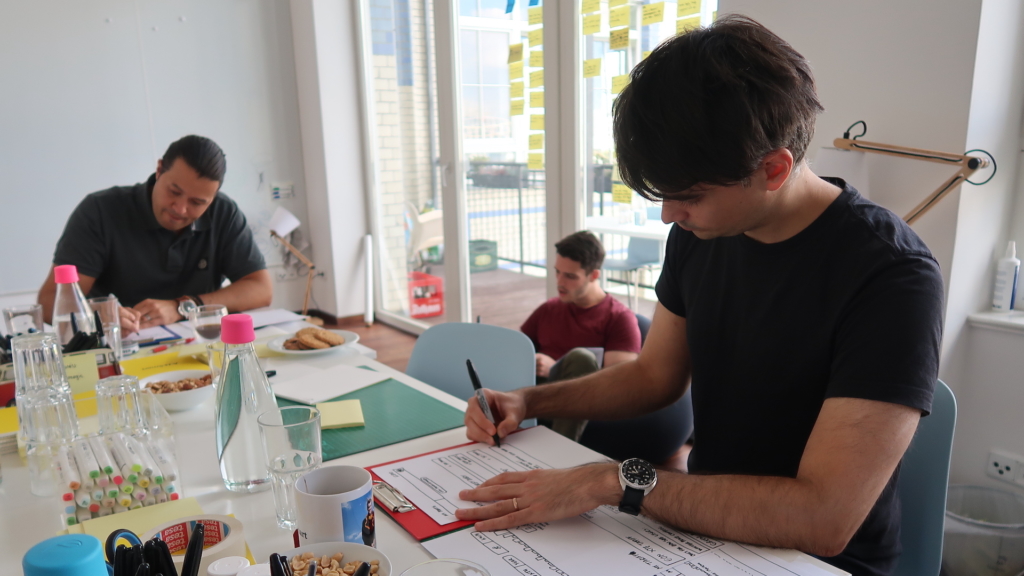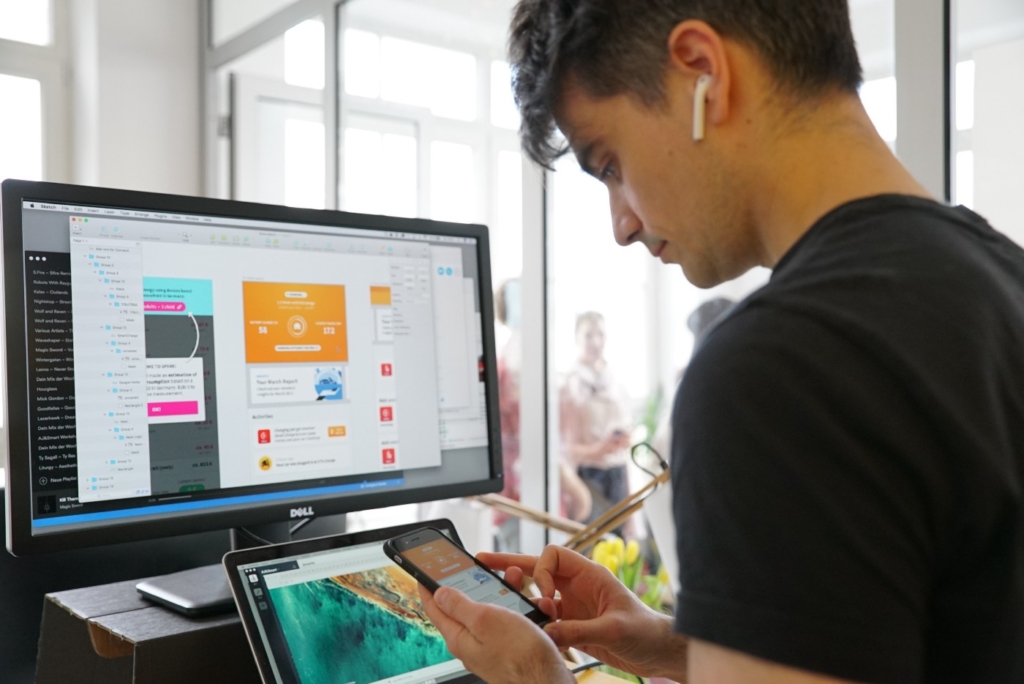A lot of people I've encountered stumble over the term "Design Sprint" at first, so let me get it out of the way right at the start:
- Design Sprints are not just for designers.
- Design Sprints have nothing to do with agile sprints.
Bluntly put, the Design Sprint is a structured, time-boxed process for applying human-centered design and Design Thinking to tackle complex challenges by ideating a promising solution, turning it into a prototype, and then testing it with users and collecting their feedback.
The Design Sprint originated in Silicon Valley. A team at Google Ventures (now GV) used the process to help portfolio companies solve problems, learn faster, and build better products. Since then, companies all over the world have adopted Design Sprints.
Design Sprints replace analysis paralysis and inertia with rapid, creative experimentation.
Why should you trust me?
Because I don't just talk the talk, but actually walk the walk. I have run Design Sprints for companies all over the world since 2016. I have experienced hundreds of Design Sprints end-to-end, from the perspective of a participant, faciliator, prototyper, and researcher. There has been hardly a week where I didn't either take part in the delivery of a Design Sprint or its preparation. Along with my colleagues at AJ&Smart, I also contributed to innovations and tweaks to the original Design Sprint process. Some of these are now used by practitioners all over the world (such as our improvement to Storyboarding, or our remote Sprint delivery). Last but not least, I share my experience in Design Sprint delivery with other practitioners in trainings and coaching calls. With that out of the way, let's dive in!

What kind of challenges can a Design Sprint solve?
Again, it's important to clarify this right at the start: Design Sprints are not for coming up with (visual) design or branding ideas. They can be used for that, but they are a lot more versatile and useful when used strategically.
A startup, for example, might use Design Sprints to validate the value proposition and product/market fit of a new, innovative product, without spending time and resources on building an untested idea. It also decreases time-to-market, because the product can launch with the features that are most valuable to users first. As an additional benefit, the outcomes of the Sprint can also be more effectively pitched to investors than an abstract business case.
A company's product team might use a Design Sprint to come up with feature ideas and test ideas before committing time and resources to build them. Opportunity costs are high, and rather than betting everything on an uncertain path, a Design Sprint gives you an idea of the direction that will have the biggest impact.
An enterprise might use a Design Sprint to align teams, improve internal processes, and build a customer-centric culture of innovation. The list could go on. The versatility of Design Sprints is one of the reasons they have taken the world by storm since 2015.
What are the outcomes of a Design Sprint?
In a Design Sprint, a mass of diverse ideas is created. But the most important outcomes are the insights, and the clarity you get by testing a prototype of some of the ideas with people from the target group.
Besides rapidly creating ideas, the Design Sprint is an excellent way of learning through experimentation. I really like this way of describing it: Imagine you are in a room with the lights switched off, and your task is to hit a dartboard in complete darkness. It's very likely you'll miss on the first try, but once you switch on the light, you see how far off you were — so you'll be much closer when you do it again. The Design Sprint allows you to switch on the light and repeat your throw without any risk.
Let me unpack quickly what exactly you hold in your hand at the end of a Design Sprint.
- Alignment on and validation of the most critical problems to solve
- Alignment on an ambitious long-term goal, that serves a North Star for the team during the Design Sprint, but can form the base for product KPIs or team OKRs
- A mass of diverse ideas from the team, each potentially a solution for the problem, and a way to reach your goal
- A high-fidelity prototype of the most promising ideas, which makes the solution idea tangible. It's build rapidly, but looks real enough to get you feedback in the user test
- Feedback on the solution prototype from a group of users. This feedback gives you clarity on the next steps
What does a Sprint Week look like?
Frame the challenge
The best use of a Sprint is to work on the biggest, most complex and most unclear challenges. At the beginning of every Design Sprint, the team explores the problem space and aligns on a focus area.
For teams, this alignment and clarity is extremely valuable, because it creates clear priorities among the many problems they are facing.
The key challenges are then framed in a standardized way that doesn't prescribe a solution. As a result, the group can create a more diverse range of ideas how to solve the problem.
Generate solution ideas
Then, every participant in the Sprint creates their own, individual approach how the problem might be solved. The entire group will quietly sketch and map out their individual ideas. However, the ideas don't need to be fully detailed, and the sketches don't have to be pretty. The important thing is to get the idea across as clearly as possible.
From this mass of ideas, the group picks one or two thatchave the highest potential to solve the challenge. By focusing on just one or two ideas, it's possible to spend more time to work out missing details, and map out how to turn the idea into a prototype that can be tested.

Build a prototype
Now that you have decided on an idea, it's very important to test it. Otherwise you miss out on a valuable opportunity to learn if you are going in the right direction.
Likewise, just describing the specs of an idea to users isn't enough, as the potential for misinterpretations is too high.
So, to get useful feedback on your idea, you turn it into a prototype. It should look and feel very close to what the real product might look like.
At the same time, it should be simple enough to test it as soon as possible. At this point, you still don't know if your idea is valid or not. To avoid a waste of time and effort, the prototype is created quickly, within just one or two days. It entirely consists of interlinked images that look like the interface and frontend of an app, product or website.

The ideal prototype is interactive and looks real and refined enough to make your testers forget that they aren't dealing with a real app or website, and give you a mass of insights and critical, but useful feedback.
At the same time, the prototype is simple enough to be able to create it quickly, and focuses on the most important features and key user journeys you want to get feedback on.
Test your ideas
At the end of a Design Sprint, you show the solution prototype to a group of testers in qualitative interviews that yield you valuable insights.
Each of the testers is recruited to match your target market's demographic and background and is interviewed for up to one hour long while they interact with the prototype.
Once you show a prototype of your ideas to people from your target group, everything becomes a lot clearer and the next steps become a lot easier to plan.
This feedback can be utilized to iterate and improve your solutions, prioritize a feature roadmap or sharpen the value proposition.

What happens after a Design Sprint?
- The feedback is used to iterate on the solution in a second Design Sprint week, where you remove things that weren't relevant, improve or add parts that were missing and double down on ideas that performed well
- You can prioritize features on a product roadmap, according to effort and impact
- The value proposition of the product can be sharpened, based on customer feedback
- You can use the prototype and user feedback to pitch your idea to investors or get buy-in from internal stakeholders, or to brief your development team
Would you like to know more?
I have run successful Design Sprints for multinational enterprises like American Express and Daimler, tech companies like Google and Twitter, to startups like N26 and Zero. Whatever challenge you are facing, I am happy to have a chat. Also, if you would like to know more about me, click here!
I am the Head of Product Design at AJ&Smart. We design award-winning products, consult on digital innovation and also offer training workshops for designers, entrepreneurs and companies.
If you would like to know more about our service offering or just want to chat, please get in touch.